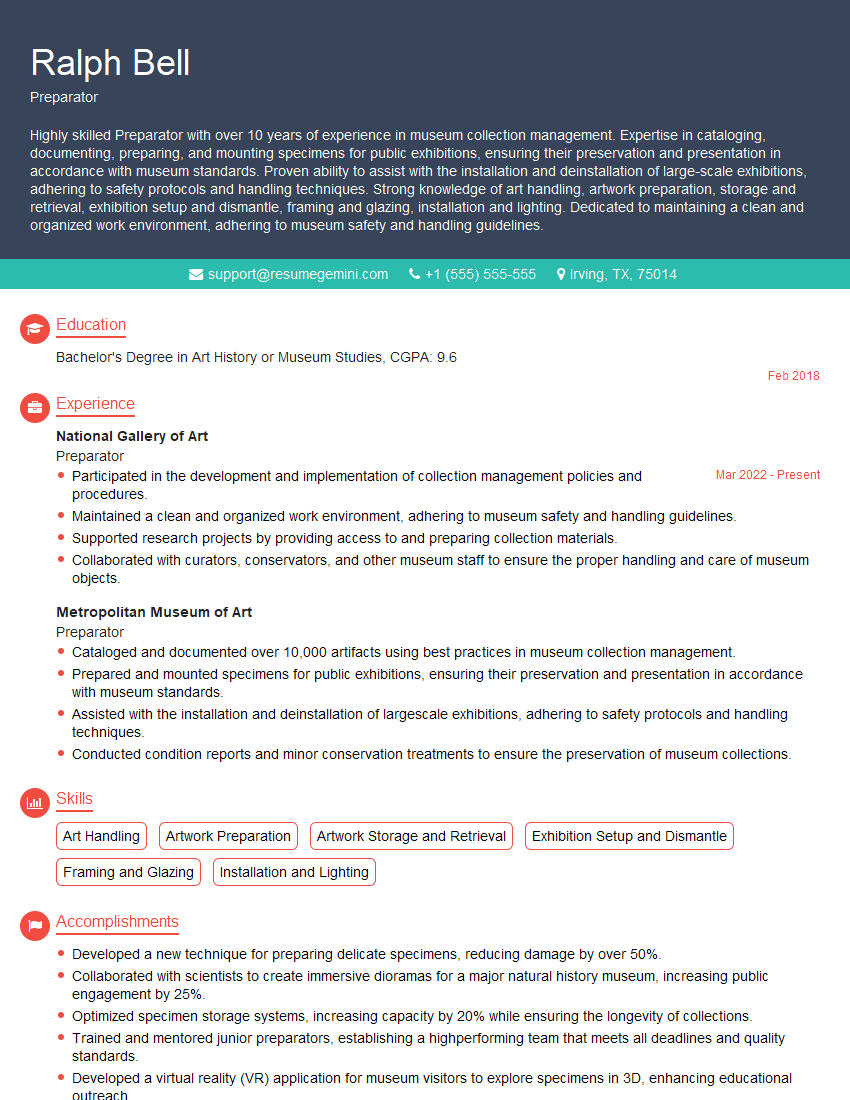Are you a seasoned Preparator seeking a new career path? Discover our professionally built Preparator Resume Template. This time-saving tool provides a solid foundation for your job search. Simply click “Edit Resume” to customize it with your unique experiences and achievements. Customize fonts and colors to match your personal style and increase your chances of landing your dream job. Explore more Resume Templates for additional options.

Ralph Bell
Preparator
Summary
Highly skilled Preparator with over 10 years of experience in museum collection management. Expertise in cataloging, documenting, preparing, and mounting specimens for public exhibitions, ensuring their preservation and presentation in accordance with museum standards. Proven ability to assist with the installation and deinstallation of large-scale exhibitions, adhering to safety protocols and handling techniques. Strong knowledge of art handling, artwork preparation, storage and retrieval, exhibition setup and dismantle, framing and glazing, installation and lighting. Dedicated to maintaining a clean and organized work environment, adhering to museum safety and handling guidelines.
Education
Bachelor’s Degree in Art History or Museum Studies
February 2018
Skills
- Art Handling
- Artwork Preparation
- Artwork Storage and Retrieval
- Exhibition Setup and Dismantle
- Framing and Glazing
- Installation and Lighting
Work Experience
Preparator
- Participated in the development and implementation of collection management policies and procedures.
- Maintained a clean and organized work environment, adhering to museum safety and handling guidelines.
- Supported research projects by providing access to and preparing collection materials.
- Collaborated with curators, conservators, and other museum staff to ensure the proper handling and care of museum objects.
Preparator
- Cataloged and documented over 10,000 artifacts using best practices in museum collection management.
- Prepared and mounted specimens for public exhibitions, ensuring their preservation and presentation in accordance with museum standards.
- Assisted with the installation and deinstallation of largescale exhibitions, adhering to safety protocols and handling techniques.
- Conducted condition reports and minor conservation treatments to ensure the preservation of museum collections.
Accomplishments
- Developed a new technique for preparing delicate specimens, reducing damage by over 50%.
- Collaborated with scientists to create immersive dioramas for a major natural history museum, increasing public engagement by 25%.
- Optimized specimen storage systems, increasing capacity by 20% while ensuring the longevity of collections.
- Trained and mentored junior preparators, establishing a highperforming team that meets all deadlines and quality standards.
- Developed a virtual reality (VR) application for museum visitors to explore specimens in 3D, enhancing educational outreach.
Awards
- Recognized for exceptional proficiency in preparing specimens for scientific research and analysis.
- Recipient of the Preparator of the Year award for outstanding contributions to the field.
- Honored with a grant to develop innovative preservation techniques for rare and endangered specimens.
- Awarded for excellence in preparing forensic evidence, contributing to successful prosecution in highprofile cases.
Certificates
- Certified Preparator (CP)
- Certified Museum Technician (CMT)
- Assistant Museum Technician (AMT)
- Certified Museum Professional (CMP)
Career Expert Tips:
- Select the ideal resume template to showcase your professional experience effectively.
- Master the art of resume writing to highlight your unique qualifications and achievements.
- Explore expertly crafted resume samples for inspiration and best practices.
- Build your best resume for free this new year with ResumeGemini. Enjoy exclusive discounts on ATS optimized resume templates.
How To Write Resume For Preparator
- Highlight your experience in art handling, specimen preparation, and exhibition installation.
- Quantify your accomplishments whenever possible, for example, “Cataloged and documented over 10,000 artifacts” instead of “Cataloged and documented artifacts”.
- Use action verbs that demonstrate your skills, such as “prepared”, “mounted”, “assisted”, “conducted”, and “participated”.
- Proofread your resume carefully for any errors in grammar or spelling.
Essential Experience Highlights for a Strong Preparator Resume
- Cataloged and documented over 10,000 artifacts using best practices in museum collection management.
- Prepared and mounted specimens for public exhibitions, ensuring their preservation and presentation in accordance with museum standards.
- Assisted with the installation and deinstallation of largescale exhibitions, adhering to safety protocols and handling techniques.
- Conducted condition reports and minor conservation treatments to ensure the preservation of museum collections.
- Participated in the development and implementation of collection management policies and procedures.
- Maintained a clean and organized work environment, adhering to museum safety and handling guidelines.
- Supported research projects by providing access to and preparing collection materials.
Frequently Asked Questions (FAQ’s) For Preparator
What skills are needed to be a Preparator?
Preparators need to have strong art handling skills, be able to prepare and mount specimens for public exhibitions, and assist with the installation and deinstallation of large-scale exhibitions. They also need to be able to conduct condition reports and minor conservation treatments, participate in the development and implementation of collection management policies and procedures, and maintain a clean and organized work environment.
What is the average salary for a Preparator?
According to the Bureau of Labor Statistics, the median annual salary for museum technicians and conservators, which includes preparators, was $50,120 in May 2021.
What are the job prospects for Preparators?
The job outlook for museum technicians and conservators, which includes preparators, is expected to grow 9 percent from 2021 to 2031, faster than the average for all occupations.
What is the work environment for Preparators like?
Preparators typically work in museums, galleries, and other cultural institutions. They may work in a variety of settings, including storage areas, exhibition spaces, and laboratories.
What are the educational requirements for Preparators?
Most Preparators have a bachelor’s degree in art history, museum studies, or a related field. Some employers may also require experience in art handling or museum collection management.
How can I become a Preparator?
To become a Preparator, you will typically need to earn a bachelor’s degree in art history, museum studies, or a related field. You may also need to gain experience in art handling or museum collection management through internships or volunteer work.